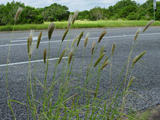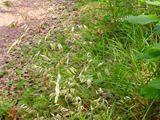Native Plants

Q. Who is Mr. Smarty Plants?
A: There are those who suspect Wildflower Center volunteers are the culpable and capable culprits. Yet, others think staff members play some, albeit small, role. You can torture us with your plant questions, but we will never reveal the Green Guru's secret identity.
Did you know you can access the Native Plant Information Network with your web-enabled smartphone?
Ask Mr. Smarty Plants is a free service provided by the staff and volunteers at the Lady Bird Johnson Wildflower Center.

rate this answer
Tuesday - August 06, 2013
From: Kerrville, TX
Region: Southwest
Topic: Drought Tolerant, Erosion Control, Grasses or Grass-like, Herbs/Forbs, Shrubs
Title: Erosion tolerant plants for shade from Kerrville TX
Answered by: Barbara Medford
QUESTION:
We have just cleared a lot of cedar out of a small draw and would like to know the best groundcovers, shrubs, etc. to plant to hold the soil. Deep shade most of the day.ANSWER:
We just answered a very similar question, with one glaring difference - you are looking for shade plants, which may be a real problem. This time we are going to our full Native Plant Database so we will have more possibilities to choose from. We are in hopes that the draw gets some water from time to time and that will assist us in finding plants for your situation. Please read our similar question first, and then we will go to our database and, using the list of specifications on the right-hand side of the page, select on Texas, then "grass or grass-like" for Habit, "dry" for Soil Moisture and both shade (2 hour or less of sun a day) and "part shade" (2 to 6 hours of sun a day) under Light Requirements. After we run that search, we will run additional searches for the Habits of "shrubs" and "herbs' (herbaceous blooming plants) and see what results we get. We have given you 4 possibillities each for Habit. We suggest, since we really don't know enough about the environment where you propose to grow these plants, that you run the searches for yourself. Each time you select a plant, go to our webpage on that plant, study its light and moisture requirements, then go down the page to Additional Resources. Click on "Find (plant name) in USDA Plants". When you get the map of North America, the green states on that map record that plant as growing natively. Click on Texas and you will get a map with the counties green where that plant grows. This helps us, and we hope it helps you, determine if the soils, climate and rainfall in your area are appropriate to that plant.
Grass or grasslike plants for shade:
Carex planostachys (Cedar sedge)
Chloris virgata (Feather fingergrass)
Melica nitens (Three-flower melic)
Nassella tenuissima (Mexican feathergrass)
Shrubs for Shade:
Acacia angustissima (Prairie acacia)
Aesculus pavia var. pavia (Scarlet buckeye)
Amorpha roemeriana (Roemer's false indigo)
Baccharis neglecta (False willow)
Herbaceous blooming plants for shade:
Ageratina altissima (White snakeroot)
Amblyolepis setigera (Huisache daisy)
From the Image Gallery
More Erosion Control Questions
Restoring a slope in the Mississippi sandhill region
August 01, 2011 - We are building on 5 acres (leaving 60% as is, natural). Only building a small (900-1200 sq ft house) & clearing 1 acre of the valley for a pond. There is a steep slope (where we had to put field dra...
view the full question and answer
Erosion control in Charleston WV
August 26, 2009 - I live in Charleston, WV and just purchased a home that has a hill side out back that has some erosion occurring. I was wondering what would be the best ground cover to plant in my area to control the...
view the full question and answer
Landscaping for slope in Kansas City
October 08, 2008 - We have a down sloping back yard and patio on the lower area. We need some water absorbing plants near the foundation and some in the front of the house, where water isn't a problem. We are allergic ...
view the full question and answer
Plants with color for steep slope in Calera, Alabama
March 26, 2010 - I have a large steep slope in my back yard that the developer called a privacy break. It has poor soil and gets full sun. I have planted muhly and maiden grasses but would like some color. The slope ...
view the full question and answer
Deer Resistance and Erosion Control for St. Louis County MO
January 03, 2014 - I am looking for deer and rabbit resistant native plants for erosion control on a steep ravine slope with part sun and part shade in St. Louis County MO.
view the full question and answer
| Support the Wildflower Center by Donating Online or Becoming a Member today. |


